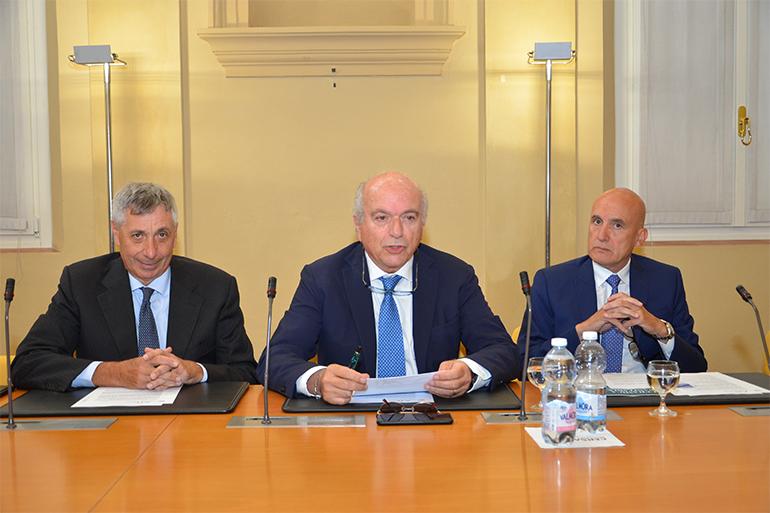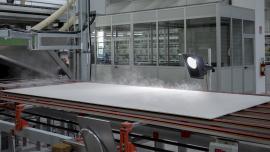The Italian ceramic industry exceeds revenues of €7.5 billion
Outgoing chairman Giovanni Savorani: “The import duties adopted in Europe are entirely insufficient to counter unfair competition.”
The Italian ceramic industry performed strongly in 2023, with revenues in excess of €7.5 billion, a workforce of more than 26,000 employees, and continued investments despite a market contraction. These figures were announced during the Confindustria Ceramica members’ meeting, where Augusto Ciarrocchi was elected chairman for the period 2024-2026. The association presented statistical surveys for 2023 regarding companies producing ceramic tiles and slabs, ceramic sanitaryware, porcelain and tableware, refractory materials, technical ceramics, and bricks and roof tiles. The industry is made up of 252 Italian companies with 26,211 direct employees and revenues of more than €7.5 billion, while companies located in Europe and North America but controlled by Italian ceramic groups posted sales revenues of almost €1 billion.
|
|
Companies |
Employees |
|
Production |
Total sales |
Domestic sales |
Exports |
Total Turnover |
Domestic turnover |
Exports |
|---|---|---|---|---|---|---|---|---|---|---|
|
|
units |
units |
|
|
|
|
|
Million € |
Million € |
Million € |
|
Ceramic Tiles |
125 |
18,432 |
Million sq.m |
373.7 |
369.2 |
84.4 |
284.8 |
6,174.7 |
1,125.6 |
5,049.1 |
|
Sanitaryware |
29 |
2,557 |
Million pieces |
3.0 |
2.9 |
1.7* |
1.2* |
348.7 |
209.2* |
139.5* |
|
Tableware |
9 |
656 |
Tonnes x 000 |
9.9 |
8.8 |
7.1 |
1.7 |
55.9 |
36.4 |
19.5 |
|
Refractories |
30 |
1,566 |
Tonnes x 000 |
252.5 |
252.9 |
118.8 |
134.1 |
344.5 |
137.7 |
206.8 |
|
Bricks & roof tiles |
59 |
3,000 |
Tonnes x 000 |
3,962.4 |
3,962.4 |
3,962.4 |
|
650.0 |
650.0 |
|
|
TOTAL |
252 |
26,211 |
|
- |
- |
- |
- |
7,573.8 |
2,158.9 |
5,414.9 |
Tile production down 13.3% in Italy. Exports down 20%.
In 2023, Italy’s tile manufacturing sector included 125 companies that produced 373.7 million square metres of tiles, marking a 13.3% decrease from 2022. The industry had 18,432 direct employees, slightly fewer than the previous year. Total sales dropped by 17.8% to 369.2 million square metres. Domestic sales within Italy amounted to 84.4 million sqm, down by 8.9%, while exports suffered an even sharper decline of 20.1%, totalling 284.8 million sqm. The total revenues of Italian tile companies stood at just under €6.2 billion, a 14.1% decrease from the previous year, with €5 billion generated from exports (-15.4%; an 82% share of turnover) and €1.1 billion from domestic sales. Investments in the sector rose by 7.4% over the previous year to €474 million, equivalent to 7.7% of total sales.
| 2022 | 2023 | Var. % | |
|---|---|---|---|
| No. of Companies | 128 | 125 | -2.3% |
| No. of Employees | 18,639 | 18,432 | -1.1% |
| Production (million m2) | 431.2 | 373.7 | -13.3% |
| Total sales (million m2) | 448.9 | 369.2 | -17.8% |
| …of which in Italy | 92.7 | 84.4 | -9.0% |
| … of which exports | 356.2 | 284.8 | -20.1% |
| Investments (million €) | 441.3 | 473.8 | 7.4% |
| Total turnover (million €) | 7,186 | 6,175 | -14.1% |
| … of which in Italy | 1,215 | 1,126 | -7.4% |
| … of which exports | 5,971 | 5,049 | -15.4% |
Ceramic sanitaryware, exports account for 40% of total sales.
Italy has 29 industrial-level companies specialising in the production of ceramic sanitaryware, with 26 of these located in the district of Civita Castellana (Viterbo). These companies collectively employ approximately 2,560 direct employees and produce around 3 million pieces of sanitaryware annually. Revenues totalled €350 million , including €140 million from exports (40% of the total).
| 2022 | 2023 | Var. % | |
|---|---|---|---|
| No. of Companies | 30 | 29 | -3.3% |
| No. of Employees | 2,652 | 2,557 | -3.6% |
| Production (million pieces) | 3.6 | 3.0 | -15.4% |
| Total sales (million pieces) | 3.3 | 2.9 | -12.4% |
| Total turnover (million €) | 396.9 | 348.7 | -12.2% |
Refractory materials industry, revenues of €344 million.
Italy’s 30 refractory materials producers employed 1,566 people and produced a total of 252,500 tons of products in 2023. Total revenues fell compared to the previous year (€344 million, -7.9%) as a combined result of more than €137 million of domestic sales and more than €206 million of exports.
| 2022 | 2023 | Var. % | |
|---|---|---|---|
| No. of Companies | 30 | 30 | - |
| No. of Employees | 1,639 | 1,566 | -4.4% |
| Production (tonnes x 000) | 301.1 | 252.5 | -16.1% |
| Total Sales (tonnes x 000) | 296.6 | 252.9 | -14.7% |
| …of which in Italy | 129.4 | 118.8 | -8.2% |
| … of which exports | 167.2 | 134.1 | -19.8% |
| Total turnover (million €) | 373.9 | 344.5 | -7.9% |
| …of which in Italy | 151.3 | 137.7 | -9.0% |
| … of which exports | 222.6 | 206.8 | -7.1% |
3,000 employees in the brick and tile sector.
The Italian brick and tile industry consists of 59 companies with a workforce of 3,000 employees and revenues of €650 million in 2023, mainly generated in the Italian market. Production totalled 3.9 million tons.
| 2022 | 2023 | Var. % | |
|---|---|---|---|
| No. of Companies | 62 | 59 | -4,8% |
| No. of Employees | 3,000 | 3,000 | - |
| Production (tonnes x 000) | 4,615.0 | 3,962.4 | -14,1% |
| Total Sales (tonnes x 000) | 4,615.0 | 3,962.4 | -14.1% |
| Total Sales (tonnes x 000) | 700* | 650* | -7.1% |
Ceramic tableware, 8 out of 10 products sold on the domestic market.
The 9 industrial-level Italian companies operating in the sector employed a total of 656 people and achieved an output of 9,900 tons and sales of 8,800 tons of finished products. Domestic sales made up 80% of the total. Revenues totalled €55.9 million in 2023 (-7%), 65% of which was generated in Italy.
| 2022 | 2023 | Var. % | |
|---|---|---|---|
| No. of Companies | 9 | 9 | - |
| No. of Employees | 654 | 656 | 0.3% |
| Production (tonnes x 000) | 9.9 | 9.9 | -0.6% |
| Total Sales (tonnes x 000) | 9.4 | 8.8 | -7.0% |
| …of which in Italy | 7.1 | 7.1 | -1.2% |
| … of which exports | 2.3 | 1.7 | -24.9% |
| Total turnover (million €) | 60.1 | 55.9 | -6.9% |
| …of which in Italy | 37.6 | 36.4 | -3.1% |
| … of which exports | 22.5 | 19.5 | -13.2% |
Savorani: “Transform the ETS and impose import duties as soon as possible.”
The association’s outgoing chairman Giovanni Savorani, handing over to Augusto Ciarrocchi, highlighted the issue of import duties and the need to reevaluate – or possibly even suspend – the ETS emissions control system. He stressed the importance of ensuring that Italian ceramic producers also have access to the Transition 5.0 plan.
“In an international environment characterised by low demand and fierce competition, it is essential to ensure compliance with Fair Trade rules,” Savorani noted. “This applies in particular to India, which is continuing to expand its exports to European markets. In the United States, the authorities recently approved a request for countervailing duties of between 400% and 800% on Indian exports. This contrasts sharply with Europe where duties currently stand at less than 10%, a level that is entirely insufficient to counter unfair competition.”
The outgoing chairman also emphasised the need for a new Housing Plan, stating, “This should address the demand for capped rents for students and temporary resident workers, and would enable us to consider the vertical development of cities by overcoming current regulatory limits. The conversion into law of the so-called “Salva Casa” (“House Saving”) Decree, if it reduces the surface areas and heights required for habitability, could revitalise the renovation market through projects involving attics and basements.”
Energy is the main focus. “It is a particularly critical factor for our competitiveness,” explained Savorani. “Current thermal energy prices underscore the urgent need for the gas release programme, which is a crucial structural measure for national energy security but is hindered by the absence of implementing decrees. The ETS mechanism is particularly critical, and in the case of the Italian ceramic industry - which accounts for 10% of the total number of sites but just 1% of emissions - is totally incapable of promoting a genuine process of decarbonisation. The cost of CO2 allowances is heavily influenced by financial speculation, which “prices in” the impact of a technological alternative to natural gas that currently does not exist, given that alternative green fuels are either unavailable or cost 3-4 times more than conventional fuels. Although the ETS mechanism is designed to partially compensate European companies most at risk of delocalisation for their higher electricity costs, the current European Commission has ignored the measure in relation to the ceramic industry. Positive signs of willingness to address these critical issues are emerging from the implementing decrees for the Transition 5.0 measures, despite the inappropriate exclusion of ETS sectors from the measure itself. The existing ETS regime blocks these sectors from participating in Transition 5.0 plans, creating a paradox whereby the Italian ceramic industry, known for having the best environmental performance and Best Available Techniques (BAT) anywhere in the world, finds itself excluded from further steps designed to complete the decarbonisation process.”
The national contract.
Savorani also discussed the renewal of the ceramic industry CCNL (national collective labour agreement), which is clearly a sensitive issue given that the strike held on 14 May this year saw the participation of almost 30% of the workforce.
“We have always sought to make proposals that protect the purchasing power of workers’ wages while ensuring company sustainability. We are also firmly committed to renewing the CCNL, which we view as a shared responsibility with the trade unions.”
Roads and logistics.
Finally, Savorani reiterated the importance of the Campogalliano-Sassuolo link road, emphasising that
“this road is vitally important and must be built as soon as possible”, along with the rail link between the Marzaglia and Dinazzano freight yards. He also called for the expansion of the single-lane section of the Pedemontana highway in Sassuolo and the construction of the third bridge over the Secchia river, “which when completed should improve traffic flow within the ceramic district”.
Source: Confindustria Ceramica
*estimated
Did you find this article useful?
Join the CWW community to receive the most important news from the global ceramic industry every two weeks


























